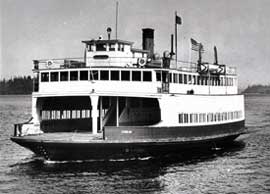 above : Crosline in service, prior to 1940. When serving in Vancouver BC, the auto deck was enclosed for passenger-only service; upon her return to the United States, the ferry was converted to double-ended operation. | |
| History | |
|---|---|
| Name | Crosline |
| Owner | Crosby Direct Line Ferries, Puget Sound Navigation Co., and others |
| Builder | Marine Construction Co., Seattle, WA |
| Launched | June 22, 1925 |
| In service | 1925 |
| Out of service | 1967 |
| Identification | US registry #224839; Radio Call Letters: WH7219 |
| Fate | Converted to shoreside structure. |
| Notes | Designed by L.H. Coolidge. Reconstructed 1947. |
| General characteristics | |
| Type | Auto/ passenger ferry |
| Length | As built : 150 ft (45.72 m) |
| Beam | As built :48 ft (14.63 m) |
| Installed power | Originally : 750 HP Sumner diesel engine. |
| Capacity | 65 automobiles |
The MV Crosline was a wooden, diesel ship launched in Seattle on June 22, 1925 for the Crosby Direct Line Ferry Company. It could carry 300 passengers and 65 cars.